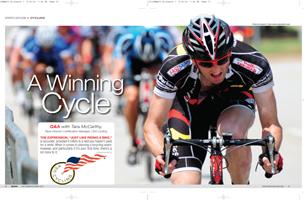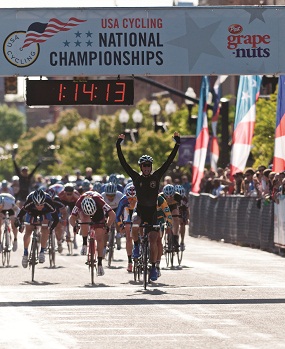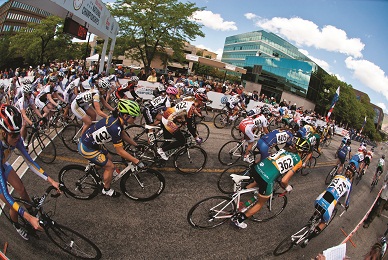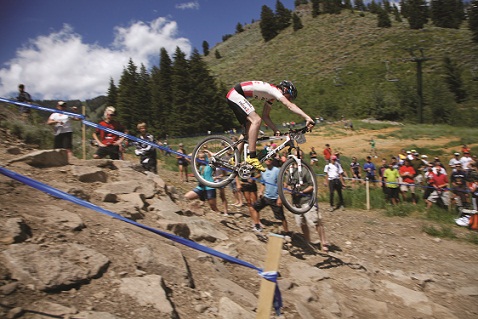
 |
| Photo by Dennis G. Esler (www.eslerphoto.com) |
The expression, "Just like riding a bike," is accurate, provided it refers to a skill you haven't used for a while. When it comes to planning a bicycling event, however, and particularly if it's your first time, there's a lot more to it.
One reason planning a cycling event is so complex is the wide variety of facilities that can be used, and the wide variety of competitive events that are held there. Bicycling as a sport encompasses five competitive disciplines, all of which are governed nationally by USA Cycling (see the adjacent sidebar for more information). USA Cycling also sanctions touring and recreational rides (which are non-competitive).
Tara McCarthy has worked with USA Cycling to create an education program for planners of bicycle events, and gave SDM some of her best practices:
 |
| Photo courtesy of Christopher See/USA Cycling |
Sports Destination Management: With so many different disciplines of cycling, it's hard to say exactly what planners should look for in a facility. Obviously, though, all bicycle events need good planning.
Tara McCarthy: Yes, and a lot of times, we work with people who want to put on a brand-new event, and they don't understand the permit process. There are two sides to work with: their own city, and USA Cycling, to have the event approved and sanctioned. We teach them how to work with both sides.
SDM: Is there a common misconception among first-time event planners?
McCarthy: Often, people don't understand how much time is needed to prepare. For a brand-new event, it can take 12 to 15 months. In some cases, cities will request a six-month wait time to review an application. Then if you're talking about a road race where roads will have to be closed or monitored, you'll need police support which means you need to be on the police schedule. You need to make sure they have availability that day and you need to make sure that no other races or events are going on in the area that day that are going to make traffic a problem.
 |
| Photo courtesy of Christopher See/USA Cycling |
SDM: Obviously, road or course conditions are important to cyclists. What sorts of things do planners need to think about and take into consideration?
McCarthy: Are there cattle grates in the roads? Are there narrow bridges? Are the roads going to be under construction in any spots? What shape are the roads in? If this is a mountain biking event and you're using a park, you'll need to work with the park officials to make sure the trails you are using are closed to everyone else for the day. You can also work to get free or reduced cost parking for your athletes.
SDM: Obviously, insurance is necessary to any bicycling event. What do event planners need to know about insurance?
McCarthy: If they're sanctioning their event through USA Cycling, they receive two kinds of insurance through us: general commercial liability, and athlete excess medical insurance policy.
SDM: What else is essential to a well-run event?
 |
| Photo courtesy of Team i4/USA Cycling |
McCarthy: Good volunteer support. You want the community not to mind that a road is being shut down, for example, and you want them to be supportive of the event, and to be ready to lend a hand. That's a huge factor, and not everyone realizes it.
SDM: It's obviously impossible to say exactly what is needed for every facility, but in general, for a bicycle event, what do you recommend planners look for in a destination, or what should a destination be ready to provide?
McCarthy: If you're planning a national event, you want it located so that people can get there easily. How easy or difficult is it going to be to get in and out? If you have to fly in, will the venue be nearby, or will people have to rent cars and drive?
SDM: Are there a lot of opportunities for children to get into bicycling now?
McCarthy: Yes, and USA Cycling has a variety of events. If it's a masters race, for example, that's more of an adult event, and kids might watch it, but they wouldn't be riding in it. But there are a lot of programs where a children's race or fun ride will be held in the morning, and an adult race later that same day. Plus USA Cycling works with a number of events for kids -- there's the Lance Armstrong Junior Race Series, and there are a number of national camps for juniors. If it's a recreational ride, everyone might ride together.
 |
| Photo courtesy of Matt Moses/USA Cycling |
SDM: USA Cycling has more than 70,000 members. Do you think awareness of bicycling as a sport is growing?
McCarthy: Interest definitely is growing. People know about the competitive events, and that's good, but I think we're also seeing an interest in and an awareness of cycling culture. There are bicycle lanes on streets, and more bicycle racks for people to use. It's becoming engrained in people's daily lives, which is great to see.
Sidebar 1:
Bicycling: The Basics of a Multi-Disciplinary Sport:
• Road racing: Road racing involves multiple riders and a common start and finish. (There may be exceptions, such as in time trials). The best-known of all bicycle road racing events is the Tour de France, but Olympic cycling recently also gave TV viewers a taste of competition on the international level. Generally, athletes in road bicycle races use racing cycles (recognizable by their lightweight frames and drop handlebars). Races vary in type, length and duration.
• Mountain bike racing: Mountain bike races also vary in length and duration. They are held off-road and involve multiple competitors cycling over terrain that may be steep, muddy or rutted, or which includes natural obstacles (logs, ledges, rocks, streams, etc.) Racers use mountain bikes, recognizable by their wider, knobbier ties and heavier frames. Parks, ski resorts (off-season) and other areas of open space are often used.
• Track cycling: A racing facility strictly for bicycling is a velodrome. It is not a multi-use facility; therefore, it is a magnet for competitive cyclists. Track bicycles resemble racing cycles but do not use brakes. Velodromes, because of their relative scarcity in the U.S., tend to attract bicycle-centric communities.
• BMX, short for bicycle motocross, takes place off-road, often on a dirt track with a BMX bicycle. Riders may also compete by performing tricks in skate-type parks, and by using ramps, jumps and other obstacles. (BMX has gained a reputation as an extreme sport, and is one of the marquee events of the Summer X Games).
• Cyclo-cross racing is a hybrid sport that involves riding both on and off paved roads.
Another discipline of cycling, Para-Cycling, is seen in the Paralympic Games. USA Cycling works in cooperation with governing bodies for this competition as well. Athletes compete on the track (velodrome) and on the roads. Track events generally consist of sprints as short as 200 meters to time trials and pursuits up to 4 kilometers. Relay races consisting of three-person teams are also contested on the track.
In addition to the above disciplines, bicycling may also include touring and recreational rides. These may be for all ages, or for a specific age group. They may be fund-raising rides, or may just be for fun and fitness. The only thing they really have in common is that they are not set up for the purposes of competition and therefore do not need to be overseen by officials for purposes of timing, etc. Organizers can work with USA Cycling to have these events sanctioned.
Routes may be urban, suburban, rural or any combination. All should have a support system for riders who suffer mechanical breakdowns, injury, etc. (The 'sag wagon' is the slang term for the vehicle that drives along the course to check on riders; it should be driven by, or staffed by, someone with bicycle-specific mechanical knowledge and first aid experience).
